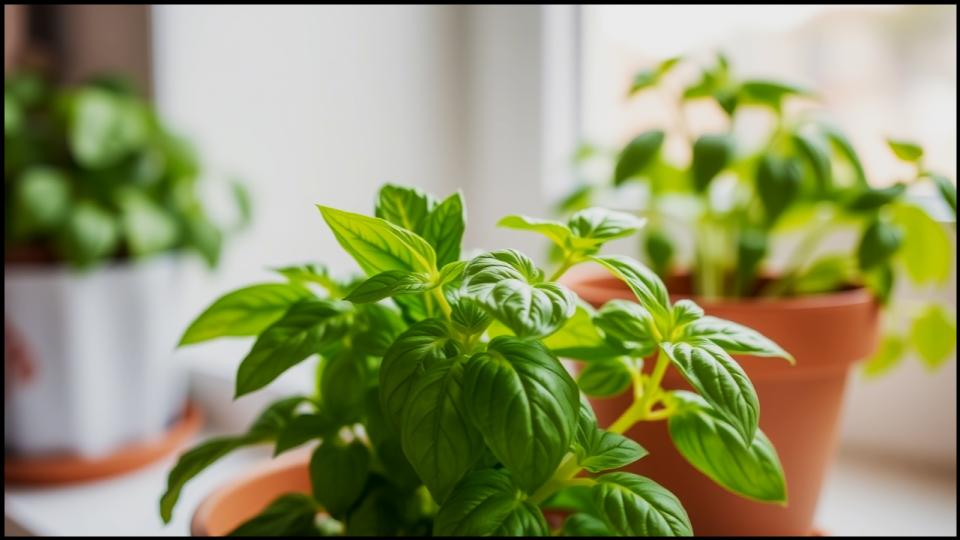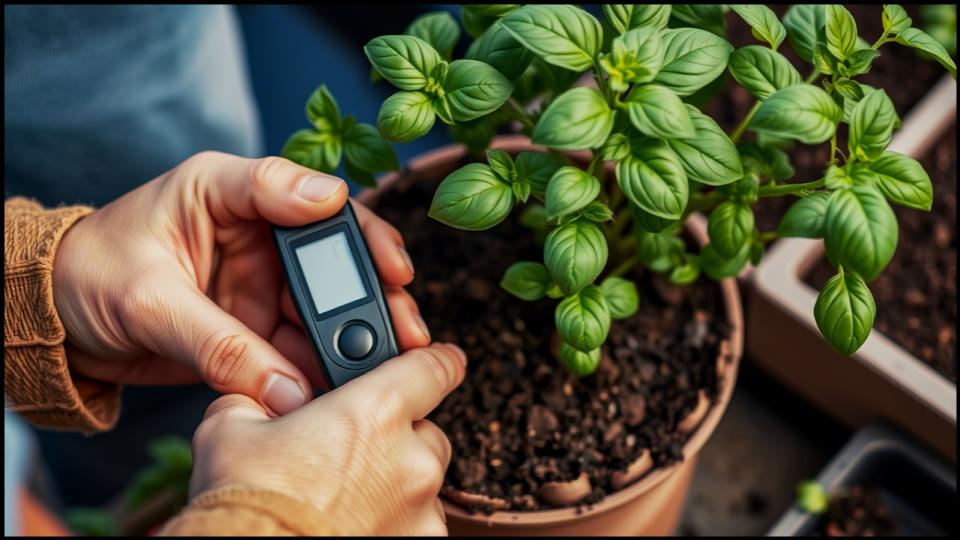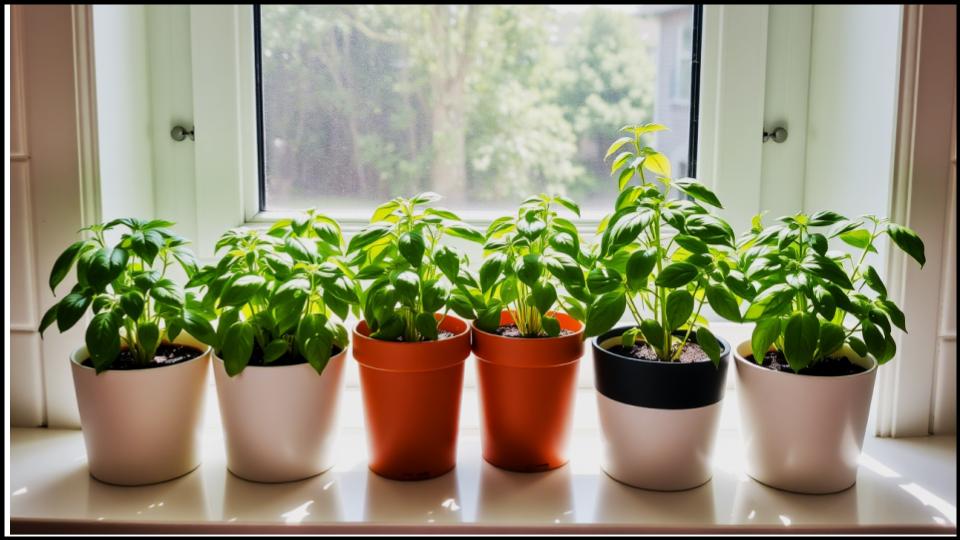It’s a familiar sight for many herb enthusiasts: you envision fragrant, perky basil leaves ready for your Caprese salads and homemade pestos, only to find a disappointingly droopy basil plant gracing your windowsill or garden patch. That gentle slump in its usually vibrant demeanor can feel like a culinary setback. But before you despair, know that a droopy basil plant is often sending out an SOS that, once understood, can be easily addressed. We’re here to guide you through the common culprits and unveil the elegant, simple fixes that will have your basil standing tall and proud again, ready to infuse your kitchen with its delightful aroma.

Here’s what your basil likely needs:
- Consistent Moisture: Water thoroughly when the top inch or so of soil feels dry to the touch.
- Ample Sunlight: Aim for at least 6 to 8 hours of bright, direct sunlight each day.
- Good Drainage: Crucial! Ensure pots have drainage holes and soil isn’t consistently waterlogged.
- Warm Temperatures: Basil thrives in warmth; protect it from chilly drafts and temperatures below 50°F (10°C).
- Gentle Handling: Avoid over-pruning, especially when young, and treat with a gentle touch.
Understanding Your Basil: More Than Just an Herb
Basil, or Ocimum basilicum, is more than just a culinary staple; it’s a plant with a rich history and a cheerful presence. Its glossy leaves, ranging from deep green to vibrant purple, bring beauty to any space, and its signature scent is synonymous with summer gardens and fresh, flavorful cooking. In my years of guiding fellow gardeners, I’ve seen how a thriving basil plant can truly elevate a kitchen garden, both in flavor and spirit. Basil generally prefers a life of sunshine, consistent warmth, and soil that’s kept evenly moist but never soggy – understanding these fundamental preferences is the first step to preventing a droopy basil situation.
The Common Culprits: Why Your Basil Plant is Drooping
When your basil starts to look less than its best, it’s usually signaling an imbalance in its environment or care. Identifying the specific cause is key to a swift recovery. A common mistake I often see, even with enthusiastic gardeners, is misinterpreting basil’s signals, especially when it comes to its hydration needs and basil problems. Let’s explore the most frequent reasons behind that disheartening droop.
The Thirsty Plant: Underwatering Your Basil
This is often the prime suspect when you see droopy basil. Basil’s tender, relatively large leaves have a high surface area through which they transpire, or lose water.
- The Signs: Besides the obvious wilting of leaves and stems, the soil will feel dry to the touch if you insert your finger about an inch deep. In prolonged cases, leaf edges might become brown and crispy.
- The Reason: Simply put, the plant is losing water faster than its roots can absorb it from dry soil. It’s a cry for hydration! According to Better Homes & Gardens, basil prefers consistently moist soil and should never be allowed to dry out completely.
Drowning in Affection: The Perils of Overwatering Basil
It might seem counterintuitive, but too much water can lead to symptoms remarkably similar to too little: a droopy, unhappy plant. This is one of the most common basil problems for well-intentioned gardeners.
- The Signs: Leaves, especially lower ones, may turn yellow and drop. The plant will wilt, but the soil will be consistently wet or even waterlogged. You might also notice a musty or foul smell from the soil, indicating potential root rot.
- The Reason: Basil roots, like most plant roots, need oxygen to survive and function. When soil is saturated, water fills the air pockets, effectively suffocating the roots. This impairs their ability to absorb water and nutrients, leading to wilting and creating an environment ripe for fungal diseases like root rot.

Seeking the Sun: Insufficient Light
Basil is a sun-worshipper, plain and simple. If it’s not receiving enough bright light, its energy production falters.
- The Signs: Plants may become leggy, stretching towards the light source. Leaves might be smaller, paler than normal, and the overall plant will lack vigor, often leading to a general droopiness.
- The Reason: Basil requires at least 6 to 8 hours of direct sunlight daily to photosynthesize effectively and maintain turgid, healthy growth, as highlighted by experts at The Home Depot. I always recommend placing basil in the sunniest spot you have; it truly basks in those rays and rewards you with robust flavor.
Sun Scorch and Heat Stress: When Good Sun Goes Bad
While basil loves sun, too much intense, direct sun, especially in very hot climates or during a heatwave, can sometimes be overwhelming.
- The Signs: You might see white or yellowish scorched patches on the leaves, or the edges might turn brown and crispy. The plant can also wilt dramatically during the hottest part of the day, even if the soil has adequate moisture.
- The Reason: Extreme heat increases water loss from the leaves beyond what the roots can quickly replenish, and very high leaf temperatures can damage plant tissues. Garden & Home suggests that providing temporary shade in very hot weather can prevent wilting from intense sun.
Temperature Tantrums: Basil’s Delicate Nature
This herb is a true warm-weather aficionado and can be quite sensitive to temperature fluctuations, especially cold.
- The Signs: Drooping is a common reaction to cold stress. If temperatures dip too low (generally below 50°F or 10°C), leaves can also turn black or develop dark spots.
- The Reason: Cold temperatures slow down basil’s metabolic processes and can damage its cell tissues. It’s native to tropical regions and simply isn’t equipped for the chill. Keep it away from cold drafts from windows or air conditioning units. Soltech notes its preferred temperature is between 65°F (18°C) and 85°F (29°C).
The Shock of the New: Transplant Stress
If your basil has recently been repotted or moved to a new location (perhaps from indoors to out), a bit of drooping is quite common.
- The Signs: Wilting occurs within a few days of the move or repotting, even if other conditions seem fine.
- The Reason: The delicate root system can be disturbed during transplanting and needs time to re-establish and adjust to its new environment. This temporary stress, as mentioned by Garden & Home, is normal.
A Cry for Nutrients: Is Your Basil Hungry?
While basil isn’t an exceptionally heavy feeder, plants grown in containers for extended periods can exhaust the available nutrients in their potting mix.
- The Signs: Slowed growth, pale or yellowing leaves (often starting with the older, lower leaves if it’s a mobile nutrient like nitrogen), and a general lack of vitality can make the plant prone to drooping.
- The Reason: Essential nutrients are the building blocks for healthy plant tissues and functions. A deficiency compromises the plant’s overall strength. The University of Maryland Extension suggests that basil grown in containers may need occasional feeding.
Uninvited Guests: Pests and Diseases
Several pests and diseases can stress your basil plant, leading to wilting and drooping.
- The Signs: Look for aphids clustered on new growth, fine webbing indicative of spider mites, or tiny whiteflies that flit up when disturbed. Stippling on leaves, sticky honeydew, or distorted growth are also clues. Diseases like Fusarium wilt cause stunting, yellowing, and brown streaks on stems, while Downy Mildew presents as yellow patches on the upper leaf surface and a tell-tale greyish, fuzzy mold on the underside.
- The Reason: Pests often feed on plant sap, weakening it directly. Diseases interfere with the plant’s vascular system or its ability to photosynthesize. According to the University of California IPM Program, common pests include aphids, whiteflies, and slugs/snails, while diseases like Fusarium wilt and downy mildew are significant basil problems.
The Simple Fixes: Your Path to a Revived, Perky Basil Plant
Now for the encouraging part! Most causes of droopy basil are easily remedied with a little know-how and prompt action.
Mastering the Art of Watering Basil
Proper watering basil is perhaps the most critical aspect of its care.
- The Technique: Always water your basil deeply until water begins to escape from the drainage holes at the bottom of the pot. This encourages deeper root growth. Then, allow the top 1 to 2 inches of soil to dry out before watering again. My personal trick is the simple finger test – if it feels dry at that depth, it’s time to water.
- Frequency Factors: How often you water will depend on your specific conditions: pot size, soil type, humidity, light exposure, and ambient temperature. Indoor basil in a small pot might need water every 2-4 days, while outdoor basil in hot weather could require daily attention, as suggested by Spider Farmer. It’s far better to water thoroughly and less frequently than shallowly and often.
- Best Practice: Water at the base of the plant, directly onto the soil, preferably in the morning. This allows foliage to remain dry, helping to prevent fungal diseases.

Illuminating Your Basil’s World: Perfecting Light Exposure
Give your basil the sunshine it craves.
- Indoors: A south-facing window that receives at least 6 hours of direct sun is ideal. If you lack sufficient natural light, supplement with a good quality LED grow light for 10-12 hours a day, keeping it a few inches above the plant, as recommended by The Spruce.
- Outdoors: Choose a spot that gets full sun. However, if you live in an area with extreme summer heat and intense afternoon sun, providing a little light shade during the hottest part of the day can prevent scorch and stress.
Creating a Comfort Zone: Temperature and Humidity
Mimic basil’s native warm and moderately humid conditions.
- Ideal Temperatures: Aim for a consistent range between 65°F and 85°F (18°C – 29°C). Protect plants from cold drafts from windows, doors, or air conditioners.
- Humidity: Basil appreciates moderate humidity levels, around 40-60%. If your indoor air is very dry, especially in winter, occasional misting can help, or place the pot on a tray filled with pebbles and a little water (ensure the pot bottom isn’t sitting in the water).
Gentle Relocation: Repotting and Alleviating Transplant Shock
When repotting or moving your basil, a gentle hand is key.
- Minimize Stress: Handle the root ball carefully. After transplanting, water it in well to settle the soil.
- Acclimatize: If moving plants outdoors, do so gradually over a week, a process called “hardening off,” to allow them to adjust to the more intense light and temperature changes. Provide temporary shade for the first few days in a new sunny spot.
- Soil Choice: Always use a high-quality, well-draining potting mix. Bonnie Plants suggests a rich, moist, but well-drained soil with a pH between 6.0 and 7.0. Amending with compost is always a good idea.
A Well-Fed Plant: Nutrient Management
Keep your container-grown basil nourished.
- Feeding Schedule: For basil in pots, a light feeding with a balanced, all-purpose liquid fertilizer, diluted to half-strength, can be applied every 3-4 weeks during the active growing season (spring and summer).
- Outdoor Care: Basil planted in garden beds with soil rich in organic matter typically doesn’t require much supplemental fertilizer. An annual top-dressing of compost is usually sufficient.
- Avoid Over-Fertilizing: Too much nitrogen can lead to lush foliage but may reduce the concentration of essential oils, thus diminishing its flavor.
Guardian of the Green: Addressing Pests and Diseases Proactively
Vigilance is your best tool against these basil problems. I always tell people, the best defense against basil problems is a good offense – healthy, well-cared-for plants are naturally more resilient.
- Pest Control: Regularly inspect the undersides of leaves and stems. Aphids and spider mites can often be dislodged with a gentle spray of water or treated with insecticidal soap if infestations are significant.
- Disease Prevention & Management: Good air circulation is paramount. Space plants adequately and avoid wetting the foliage. If you spot signs of fungal disease like downy mildew (yellowing tops of leaves, grey fuzzy growth underneath), remove affected leaves immediately. The University of Minnesota Extension emphasizes that resistant varieties are the best prevention for downy mildew. For Fusarium wilt, which causes wilting and browning of stems, there is unfortunately no cure; infected plants should be removed and discarded to prevent spread to other susceptible plants. Do not compost diseased plants.
TOOLS AND MATERIALS BOX:
- Well-draining potting mix: Choose a quality mix, ideally organic, for container planting.
- Pots with ample drainage holes: Terracotta pots are excellent as they allow for better soil aeration.
- Watering can with a gentle rose or spout: For targeted watering at the soil level.
- Balanced liquid fertilizer: Preferably organic, for occasional feeding of potted basil.
- Sharp, clean pruning snips or scissors: For harvesting and pruning.
- Grow lights (optional): A boon for indoor gardeners lacking sufficient natural light.
- Insecticidal soap (use as a last resort): Have some on hand for stubborn pest outbreaks, always following label directions.]
Beyond Revival: Nurturing a Thriving Basil Patch
Once your basil has perked up, your goal shifts to maintaining its vigor and ensuring a continuous, aromatic harvest. This is where good basil plant care truly shines.
The Art of Pruning: Encouraging Bushy, Abundant Growth
Regular pruning is the secret to a full, productive basil plant.
- How and Why: Once your plant has several sets of true leaves (perhaps 6-8 inches tall), begin pinching or snipping off the top set of leaves, right above a node where two smaller leaves are emerging. Each time you do this, the plant will send out two new stems from that point, leading to a much bushier plant.
- The Benefits: This not only gives you more leaves to harvest but also prevents the plant from becoming tall and leggy. Crucially, it helps delay “bolting” – when the plant focuses its energy on producing flowers and seeds, causing leaf production to slow and flavor to diminish. Ugaoo notes that regular pruning encourages bushier growth.
Harvesting with Finesse: For Flavor and Plant Health
Think of harvesting as a delicious form of pruning!
- When to Harvest: The best time to harvest basil leaves is in the morning, after any dew has dried but before the sun becomes too intense. This is when the essential oils responsible for its flavor and aroma are at their peak.
- How to Harvest: You can pinch off individual leaves as needed. For a larger harvest, snip stems, always cutting just above a pair of leaves. This encourages the plant to branch out from that point. Avoid taking more than one-third of the plant’s total foliage at any single time to ensure it has enough energy to continue growing robustly.
From Garden to Table: Styling with Your Beautiful Basil
There’s an undeniable charm in having fresh basil at your fingertips, and it lends itself beautifully to kitchen décor.
- Windowsill Wonders: A row of healthy basil plants in attractive terracotta or ceramic pots on a sunny kitchen windowsill is both practical and picturesque.
- Herbaceous Groupings: Combine basil with other herbs like parsley, rosemary, and thyme in a larger container for a mini herb garden right outside your door. Its lush green (or purple!) foliage adds lovely texture.
- Aromatic Bouquets: Did you know you can keep cut basil stems fresh for several days? As Martha Stewart often advises, treat them like cut flowers: place the stems in a glass of water at room temperature (don’t refrigerate the leaves, as they can blacken). Cover loosely with a plastic bag to create a mini-greenhouse effect.
- The Finishing Touch: There’s such satisfaction in snipping fresh basil from a plant you’ve nurtured, right before adding it to a bubbling tomato sauce, a vibrant Caprese salad, or blending it into a heavenly homemade pesto. It’s a simple luxury that connects your garden directly to your plate.

Over to you
A droopy basil plant might cause a moment of concern, but it’s usually a straightforward invitation to reassess its care. By understanding its needs for consistent moisture (but not waterlogged soil!), abundant sunshine, warmth, and good air circulation, you can quickly diagnose the issue and set your plant back on the path to verdant glory. Regular, thoughtful basil plant care, including proper watering basil and timely pruning, will not only prevent future drooping dilemmas but also reward you with a continuous supply of its incomparably fresh, aromatic leaves.
With a little understanding and attentive care, your basil will not only recover but flourish, providing you with that quintessential taste of summer all season long. Happy gardening!
Read More
The Truth About Banana Water for Plants—Experts Reveal What Happens
You’re Probably Caring for Your Polka Dot Plant All Wrong—Here’s What Experts Say to Do Instead
